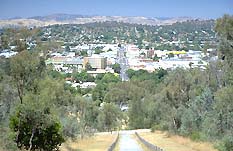
|
| The view of Albury from
Monument Hill lookout |
Albury (including Wodonga and Ettamogah)
Major city on the NSW-Victorian border.
The twin towns of Albury and Wodonga, although they are 7 km
apart and on opposite sides of the Murray River, form a
large urban area which is the border between New South Wales
and Victoria. They have populations of 39 975 and 23 639
respectively. The two are usually referred to as
Albury-Wodonga. Albury is indisputably the more interesting
and attractive town. Located 567 km south-west of Sydney via
the Hume Highway and 183 m above sea-level it has a
well-developed manufacturing industry and is an important
service centre for the surrounding area which supports
agricultural, dairying and pastoral industries.
Building on long-established traditions Wodonga is one of
the largest stock-selling and shipping centres in Australia
with importing and exporting facilitated by inland port
status. It is, however, now little more than a modern
suburban area for people who live and work in the
surrounding area.
The area around the Murray was once inhabited by the
Wiradjuri Aborigines. In 1824 Hume and Hovell explored from
Appin in New South Wales to the new settlement at
Westernport Bay in Victoria. Arriving at the future site of
Albury they carved some remarks into the trunks of two
trees. Hume's tree was destroyed in the 1840s by a
teamsters' campfire but Hovell's still stands.
They crossed the river, which they called the Hume, 16 km
upstream, where the Hume Weir now stands. Unaware of their
claim Charles Sturt later named it the Murray River and the
two titles initially competed for favour.
Squatters followed the explorers and the first land in
the area was taken up in 1835 when William Wyse established
the Mungabareena station for Charles Ebden on the northern
side of the river.
In 1836 Ebden crossed the river and opened a station at
Bonegilla and then at Thurgoona with Wyse as his stockman.
In 1837 Paul Huon arrived establishing the Wodonga station.
Albury grew because it was located at a spot where the
river was fordable. Indeed it was initially known as The
Crossing Place. It became a favourite resting place for
drovers and stockmen headed for Port Phillip (i.e.,
Melbourne).
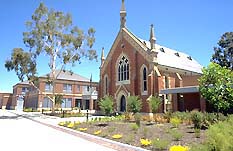
|
| The old Methodist Church,
now part of the Albury Police Station which is next
door |
Settlement of Albury began when a police hut was
established as part of a strategy to secure both the route
to Port Phillip and the settlement of inland Australia from
ongoing black resistance. Local Aborigines had been killing
the stock of the Europeans, which was displacing their
traditional food sources.
In 1838 Robert Brown built a slab hut which he developed
as a store near Hovell's Tree. A mail service was
established from Yass to Port Phillip, a few tradesmen took
up residence and a townsite on the northern bank was
surveyed as 'Bungambrewatah', a Wiradjuri term meaning 'the
crossing place'. The name was changed to Aldbury then
gazetted the following year as Albury, after a village in
England.
By the end of the 1830s the journey between Sydney and
Port Phillip was being made with sufficient frequency to
prompt the government to prepare a plan of the 'road' from
Gundagai to Port Phillip, actually a rough bush track
following the course of Hume and Hovell.
In 1841 the population was said to be seven. Robert Brown
opened the Hume River Inn in 1842, the second house being
built by James Wyse in 1843. Brown added a log punt in 1844
to help foot passengers and sheep cross the river. Everyone
complained that it was too expensive and too slow. Still,
they used it.
A clergyman observed that the Albury races had been
established on the flats beside the river before anybody had
been concerned to build a church. The Albury Cup was first
run in 1845.
Gold finds in Victoria drew the population away from
Albury (442 in 1851) and development was slow. Wodonga,
gazetted as Belvoir in 1852, became an important river port
for the Ovens goldfield. Its name was changed to Wodonga in
1874 and it subsequently became a major stock selling
centre.
After Victoria separated from NSW in 1851 the two towns
became customs posts enforcing tariffs. Goods tended to be
cheaper in NSW so Victorians would swim their stock across
the river and women bought clothes and groceries over the
border, wearing several layers of clothing home past the
customs point. While flour and bread were taxed dough was
not so Victorian bakers set up dough houses in NSW and
ferried it back across where it was made into bread. During
outbreaks of contagious disease, such as the influenza
pandemic of 1919, the border was sealed and guarded at
gunpoint
After the gold fever passed a number of Chinese settled
in Albury and established vegetable gardens on the rich
river flats just north of the present railway bridge. By
1878 there were 150 people at a Chinese camp which developed
at the corner of Townsend and Hume Sts.
The Albury Border Post newspaper was established in 1856
and the town became a municipality in 1859. The first toll
bridge was erected across the river in 1861.
The paddle steamer on the Albury coat-of-arms is a
reminder of the role that river transport played in local
development after the first river steamer, the Albury,
arrived in 1855.
Wodonga was connected to Melbourne by rail in 1873 and
the track from Sydney arrived at Albury in 1881. A temporary
wooden railway bridge joined the two in 1883.
The two states had different railway gauges until 1962,
when the first train ran straight through from Sydney to
Melbourne. The states could not initially agree which should
be the transfer point so they had an expensive and
attractive iron lattice bridge sent from England which
accommodated both gauges, 180 m long and 10 m downstream of
the temporary structure. It is still standing.
From 1886 passengers and freight had to change trains at
Albury. The station had two clocks, one for Albury and one
for Wodonga time as there was 25 minutes difference before
Eastern Standard Time was instituted. Albury subsequently
became an important rail centre and there was talk of
establishing it as the capital of a federated Australia. It
was declared a city in 1946.
Army camps were established at Bandiana and Bonegilla,
east of Wodonga, during the Second World War. Both provided
local employment. Bonegilla became Australia's largest
migrant reception centre - 320 000 people passing through
from the mid-1950s to the mid-1960s. Many chose to settle in
the Albury-Wodonga area.
Albury-Wodonga benefited from a political commitment to
decentralisation in the 1970s. Wodonga was proclaimed the
first 'rural city' in Australia in 1973.
Annual events include the Albury Festival of Sport, which
unfolds over February-March, the Albury Gold Cup Festival
and the Wodonga Show, which both take place every March, the
Albury-Wodonga Wine and Food Festival in September-October,
the Albury Show and the Bonegilla Festival in October, the
Albury-Wodonga International Festival in November and the
Ngan Girra Festival which is held at the Mungabarina Reserve
in November.
Things to see:
![[Top of page]](smlArrow.gif)
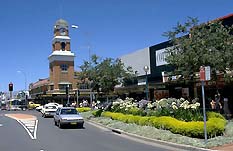
|
| The Colonial Mutual Life
Assurance Building in Dean Street
|
Historic Buildings
The growing prosperity of Albury from the 1850s can be seen
in the impressive Victorian civic buildings on Dean St
between Kiewa and Olive Sts. The Classical Revival
courthouse (1860) is one of the few remaining buildings
designed by colonial architect Alexander Dawson. The large
and imposing two-storey post office (1875) features arch
work buttressed by a colonnade and a clock tower with cupola
and weather vane which was added in the 1920s. The largely
unaltered Classical building that houses the technical
college was formerly the telegraph office (1885). The CML
building has a five-storey clock tower with curved copper
roof. The ANZ Bank (c.1915) is a large Edwardian bank with
terracotta tiled roof. By contrast, the T & G Building,
dating from the mid-1930s, features a far more modern
design, the highlight being a five-storey tower with
extremely long, thin vertical window recesses and a ziggurat
summit.
Albury Regional Art Centre
The Albury Regional Art Centre is situated within a
splendid, ornate and virtually unaltered Edwardian town hall
(1907) with cupolas and extravagant stucco. It has an
impressive collection of works by one-time resident Sir
Russell Drysdale and is open daily (02 6023 8187). Next to
the new Town Hall is a hall from the original 1860 house of
assembly.
St Matthew's Anglican Church
The foundation stone of St Matthew's Anglican Church at 514
Kiewa St was laid in 1857. The original Norman design, by
noted architect Edmund Blacket, was never completed. While
the nave, choir vestry and campanile are his the contrasting
Gothic elements, notably the chancel, vestries and transepts
were designed by J. Boles and added in the mid-1870s. The
pipe organ was added in 1876 and the church was built of
local stone.
Kia Ora
'Kia Ora' (1858-59), at 473 Townsend St, is Blacket's former
branch building for the Bank of NSW, a two-story Italianate
granite building with neoclassical detailing, now restored
and part of the Albury Base Hospital. Elm Court (1885) at
435 Townsend St is also of note.
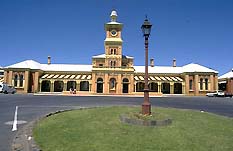
|
| Albury Railway Station
|
Albury Railway Station
Another major architectural feature of the town is the
Italianate red-and-white brick railway station (1881) in
Railway Place which which has a 22-m clock tower, original
cedar joinery and a cast-iron platform with fluted columns.
It is the third-longest platform in Australia (the longest
in NSW) owing to its role as changeover point. Its
extravagance may owe something to the competition between
the two towns. The station master's residence is also worth
a look and has attractive gardens.
Albury Regional Museum
The Albury Regional Museum is housed in the former (and
restored) Turk's Head Hotel (1860s), once the most popular
venue in town. It is located in Wodonga Place and is open
10.30 - 4.30 seven days a week (02 6021 4550).
Bellevue and Soden's Hotel
'Bellevue' at 592 Kiewa St (c.1860) is an excellent
Victorian house with impressive cast-iron decorative work
and the primary school (1881), at the corner of David and
Smollett Sts, is also a noteworthy addition to the
cityscape. At the south-east corner of David and Wilson Sts
is Soden's Hotel Australia which has fine wrought iron
awnings with glass panels.
Entertainment for Children
Frog Hollow Recreation Park in Olive St has mini golf, lawn
snooker, a giant maze, theatrical performances, a water
playground, a picnic/barbecue/playground area and a cafe
(02-6041 1117). There is a performing arts centre in Swift
St and Haberfields Mill Dairy Shop, at 482 Hovell St, offers
tours and tastings by arrangement during business hours
(02-6021 3455). Children may enjoy a trip across the river
on the Wymah Ferry, about 1.5 hours drive north-east of
Albury.
Parks in the area
On the northern riverbank, off Wodonga Place, are a series
of parklands - Oddies Creek Park, Noreuil Park, Hovell Tree
Park, the Sportsground, the Botanic Gardens, Mates Park and
Padman Park. Here are a kiosk, barbecue and picnic
facilities, swimming spots, walking tracks and the Hovell
Tree. The original inscription has disappeared beneath new
growth but a bronze plaque contains a facsimile.
Also in the parklands is a nineteenth-century iron
waterwheel from the Tallandoon goldfield, where it powered a
stamp battery. It is very rare as most were made of wood and
hence have been destroyed. The wheel was purchased by local
farmers, the Harper Brothers, who used it until 1948 to
power farm equipment. It has a 5-metre diameter with
capacity for 60 attached buckets.
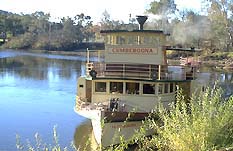
|
| P.S. Cumberoona on the
Murray near Albury |
P.S. Cumberoona
The P.S. Cumberoona, a replica of an 1886 paddle steamer
which once used to visit Albury, offers one-hour tours of
the Murray every day in season (02 6041 5558). Near its
mooring point in Noreuil Park a reproduction Cobb & Co.
coach.
Botanical Gardens
The Botanical Gardens (1871) has some interesting trees,
including a 30-m Queensland kauri, several river red gums
grown from seeds of the Hovell Tree and a pine which grew
from a seed taken at Lone Pine in Gallipoli. Also in the
gardens is the Hume Monument which was built in America and
erected in place of the destroyed Hume Tree in the late
1850s. In 1884 it was moved to the gardens from its original
site by the riverbank as it was being misused as a mooring
point by riverboats. The band stand was built in 1890.
Monument Hill Lookout
On the northern side of the Riverina Highway, opposite Mates
Park, is the panoramic view available from the lookout at
Western Hill, now known as Monument Hill due to the 30-m war
cenotaph there. Rising 90 m above the city, the hill offers
a views right down Dean St. To the south lie Wodonga and, on
the horizon, the Victorian Alps.
Eastern Hill looks north and east with the Snowy
Mountains and Hume Dam in the distance. Directly below the
hill is Mungabareena Reserve. Here, at this precise
location, the Aboriginal tribes from the high plains met for
centuries to celebrate spring. They laid aside their arms
and their differences, celebrated, then travelled north to
Mt Beauty and Mt Buffalo where they feasted on the bogong
moth. In its place the Bogong Moth Festival is now held on
the last weekend of November. It is a time for the
exploration of Aboriginal culture. There is painting,
folklore, traditional foods and dance and a wealth of
Aboriginal talent. There is also a journey to the high
country.
The Hume Dam
The Hume Dam, 16 km east of town, built between the end of
World War I and 1936, arose out of the River Murray
Agreement. At the time it was the largest dam in the
southern hemisphere and one of the world's largest. Its
surface area is 20 190 ha, its total length 1.6 km, its
capacity nearly three million megalitres and it covers 343
km of shoreline.There are 29 regulating gates, each 6 x 8 m,
and a hydro-electric station has been established to best
utilise the volume.
Spanned by Bethangra Bridge Lake Hume is used for
swimming, sailing, water skiing, paragliding, fishing,
sailboarding, jetskiing and canoeing. There are picnic,
barbecue and children's play facilities, a spectacular dam
wall, scenic countryside, swimming beaches, boat ramps,
stores, canoe hire, camping and a holiday resort which
houses a giant waterslide.
Hume Weir Trout Farm
Hume Weir Trout Farm nearby has thousands of rainbow trout
from fingerlings to adults which can be hand-fed or fished.
Fish food, bait and rids are supplied. There are waterfalls,
landscaped gardens and a kiosk. It is open daily from 9-5
(02-6026 4334).
Albury Airport
The airport, off the Riverina Highway, has a large DC2
aircraft as a monument to recall the occasion, in 1934, when
the people of Albury helped a distressed Dutch airliner lost
in fog while it was competing in an international race. They
assembled at the local racecourse (adjacent the current
airport) and turned on their headlights to successfully
guide the plane down. 300 volunteers helped pull it out of
its bogged position the next day. After it went on to claim
second place the people of the Netherlands took out a public
subscription for a monument which was sent to Albury.
Ettamogah
12 km north-east of Albury, on the Hume Highway, is
Ettamogah Wildlife Sanctuary, established to care for sick,
injured or orphaned animals. Open daily there are also
barbecue facilities and a kiosk.
The central attraction of Ettamogah, however, is the
Ettamogah Pub. Cartoonist Ken Maynard, who lived in Albury,
wrote a comic strip in which he depicted the goings-on at an
imaginary hotel called the Ettamogah (suitably it is
considered to be an Aboriginal word meaning 'place of good
drink'). In 1987 an actual pub was made that was an exact
replica of the cartoon pub , complete with seemingly
impossible design - outward leaning walls and verandahs, a
tree that stands in the middle through two floors, a jalopy
on the roof and signs everywhere. It is situated on the Hume
Hwy, at the corner of Table Top Rd, 16 km north of Albury
(02-6026 2366). Cooper's Ettamogah Winery is 400 m from the
pub. A little further south on the highway is the Norske
Skog, a newprint mill which offers tours by appointment
(02-6058 3111).
Talmalmo
In Talmalmo the Dora Dora pub (02-6037 3221), once a
stopover for Cobb and Co coaches, is still standing 130
years on, though the village has gone. It can be found 26 km
south-east of Woomargama, which lies on the Hume Highway 15
km south of Holbrook.
Wodonga
In Wodonga the National Museum of Australian Pottery at 66
South St, open Sundays and public holidays from 10.00 am -
4.00 pm, features a collection of 19th-century Australian
pottery. Edwards Tavern at 1 Moorefierld Park Rd (02-6056
1356) has an historic photograph display and Sumsion Gardens
has a lake, barbecues, picnic facilities, birdlife, walking
paths and a children's playground. 5 km south-east of
Wodonga at Bandiana is the RAAOC Museum (02-6055 2525). Open
seven days a week it has a large collection of material on
Australian history as well as barbecue, picnic and
playground facilities. Schmidt's Strawberry Winery is
located at Allans Flat (02-6027 1454). Follow the signs from
Wodonga. Continue along the Kiewa Valley Highway past
Bandiana, take the Yackandandah turnoff and follow the
signs.
Hume and Hovell Walking Track
Lovers of walking can truly get their fill on the Hume and
Hovell Walking Track which follows the explorers' path from
Albury to Gunning, 370 km north-east. It is a 22-day trek
but it is possible to opt for half or whole-day and weekend
walks. Contact the Department of Lands, 22-23 Bridge St,
Sydney (02-9228 6111).
Other Attractions
There is plenty of good fishing in the area for trout,
redfin and Murray cod. Albury also has a golf club and
Wodonga has the largest tennis complex in the southern
hemisphere. Day tours of the area, bush walking, winery
tours, horse riding and ballooning can be arranged by
phoning the Gateway Information Centre. A.W. Backpackers, at
the corner of David and Smollett Sts, furnish two-day
camping and canoeing tours along the Murray as well as
combined canoeing-winery tours (02-6041 1822).

Broadwalk
Business Brokers
Broadwalk Business
Brokers specialise in General Businesses for Sale, Caravan Parks for
Sale, Motels for Sale, Management Rights & Resorts for Sale, Farms for
Sale, Hotels for sale,Commercial & Industrial Properties for Sale.
Phone:
1300 136 559
Email:
enquiries@broadwalkbusinessbrokers.com.au
AUSTRALIAN BUSINESSES FOR SALE
COFFS HARBOUR BUSINESS BROKERS
BROADWALK BUSINESS BROKERS
GOLD COAST BUSINESSES FOR SALE
BRISBANE BUSINESSES FOR SALE
SYDNEY BUSINESSES FOR SALE
CARAVAN PARKS FOR SALE
BUSINESSES FOR SALE
MOTELS
FOR SALE
HOTELS
FOR SALE
Disclaimer
We advise prospective purchasers that we take no
responsibility for the accuracy of any information in the business
provided by vendors or their professional advisers and that they should
make their own enquiries as to the accuracy of this information,
including obtaining independent legal and/or accounting advice
Albury